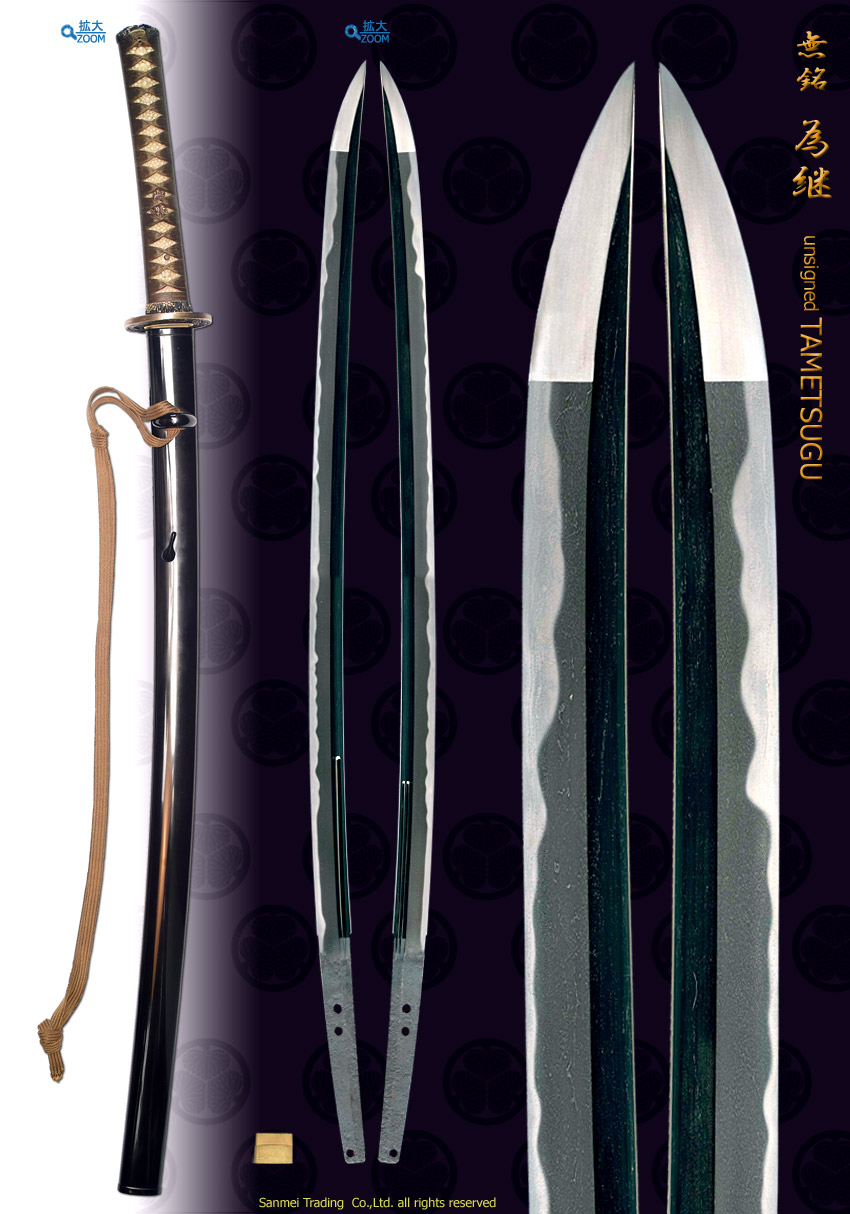with) Black lacquered scabbard Tensho style Koshirae fitting
Length of cutting edge 69.6cm Curvature 1.2cm Width of base 27.9mm Width of Yokote 23.1mm Thickness of base 6.8mm
Forging(Hada): Steel gives off darkish blue impression. Forging is conspicuous large Itame-hada with flowing indication of Masame ware mixing with swirl of Mokume hada ware. Ji-nie granule attaches on surface that emits sparkling reflection. Darkish thick lines of Nie so called "Chikei" activity appears from steel.
Temper(Hamon): Hamon is "Nie" hard metal granules based, Small Gunome and Togari-ha along Notare wave boundary line. Upper the blade Monouchi area, taller the Hamon to form large Gunome, brighter the sparkling Nie and deeper the Nioi mist. The quenching activities of frequent "Ashi" appears and "Sunagashi" long lines of Nie, "Kinsuji" or "Inazuma" thick curved lines of Nie runs crossing the feet. The interior of temper is filled with mist-like crystallize area deeply. The entire quenching effect is full of variety that comes from "Nie" extremely hard metal granule activities that are typical of Soshu works in the prime of Nanbokucho period.
Temper of tip(Boshi): Temper of boshi forms irregular stirring lines of flame sweeping indication "Hakikake" then terminates with "Yakizume" in no return.
Tang(Nakago): The tang is substantially shortened "Ōsuriage" to be unsigned with greatly slanting left Katte-sagari filemarks. Horizontal "Kiri" heel shape, three Mekugi-ana holes.
TAMETSUGU 為継 was active around Ouan era (1358-74) in 14th century, Echu province (now, Toyama pref.). He has been said a son of Go YOSHIHIRO 郷義弘 who was a leading head of the 10 genius disciples of MASAMUNE 正宗, however due to an early death of his father Go YOSHIHIRO 郷義弘, it is said that he actually took lesson from NORISHIGE 則重 in the same school of MASAMUNE 正宗.
From an old literature of Oshigata, there are two records of works signed Echizen-koku Fujiwara TAMETSUGU 越前国藤原為継 dated Enbun 2 (1357) and Ouan 2 (1370) and there is a posthumous wakizashi dated Ouan 6 (1373) signed Nouoshu-ju Fujiwara TAMETSUGU 濃州住藤原為継 応安六年癸丑六月日. Therefore it is understood that he had moved from Echizen to Fuwa-gun, Mino (now Akasaka town, Ogaki city) from 1370 till 1373.
The founders of Mino-sword makers had emigrated to Mino province from the other regoins on after Nanbokucho period and entered a new lineage of Mino tradition, such as KANEUJI 兼氏 from Yamato to Tagi-gun, Shizu (now, Shizu town, Nan'no-cho, Youro-gun), KANESHIGE 金重 from Echizen to Seki and the subject TAMETSUGU 為継 to Akasaka. Mino sword makers had been flourished untill end of Muromachi period.
Workmanship of TAMETSUGU closely resembles one of Go YOSHIHIRO to add some characteristics of his own, a bit on wider side of Mihaba, less degree of curvature and thickness leading to an extended large Kissaki. Also forging style shows a peculiar way of Matsukawa-hada like pine bark which was initiated from master NORISHIGE 則重.
These styles are commonly found from pure Soshu works during the prime Nanbokucho age and the most of them are substantially shortened to be unsigned by future generations due to the changes of battle style from horse riding to the battle on foot.
Black Roiro lacquered scabbard Tensho style Koshirae consists of : (click HERE for the entire koshirae and HERE for each fitting)
- White lay skin golden brown silk cord Hoso-ito Kumiage style lozenge wrap hilt
- Menuki : Dragon design, Yobori carving gold Iroe
- Fuchi/Kashira : Wise leaders design, Shakudo ground Takabori carving Iroe inlay, signed Kan'eishi Nomura KANENORI 干英子 野村包教
- Tsuba : Tartar design, Iron ground, Nikubori carving, Gold, silver, Shakudo inlay signed HISANORI 久則.
Double layers gold foiled Habaki collar, preserved in Shirasaya plain wood mounting
reference data : Suzuki Takuo/Sugiura Yoshiyuki, Muromachi-ki Mino-toko-no kenkyu, Ribun shuppan, 2006

